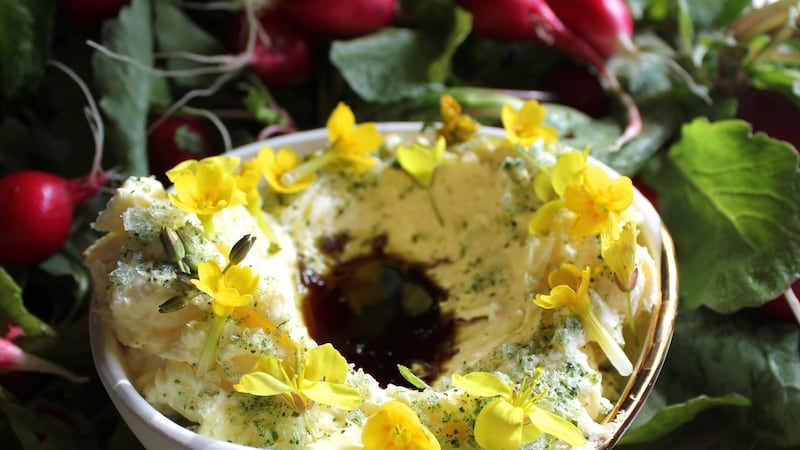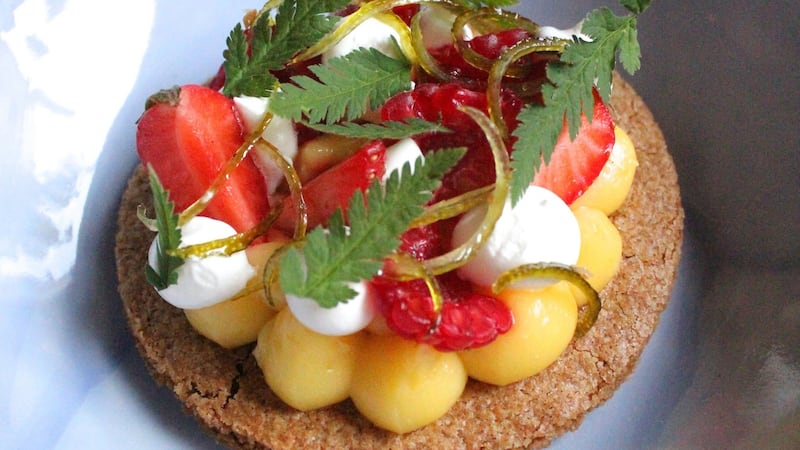Being a New Zealander, I can’t wait for summer evenings. The kind where you don’t really want to cook because it’s warm. The kind of evening when you rummage through your fridge instead and put together a little appetiser plate with some cheeses, meats, crackers and bread and head out to your yard with a glass of wine to enjoy the cool breeze. Those are my favourite kind of summer nights – and they will soon be here. And you’d better believe that I will have these three saucy recipes on hand for the occasion.
First up, when simple meets delicious. Whip up the perfect combo of two of life’s blessings – butter and buttermilk. Then put some on any dish that could use an upgrade. This is not so much a recipe as it is a way of life. Once you have whipped your butter, you will never go back. Just be sure to use real butter, no substitutes here – or ever. Whipped butter is simply regular butter that has had air beaten into it in order to increase the volume. It also makes the butter much easier to spread and quicker to melt, delivering its buttery payload over dishes much faster.
In the restaurant, we make sweet butters to serve with pancakes – you can mix in a little honey, icing sugar or orange peel for added flavour, cinnamon works very well too. For savoury butter, try roasted garlic, chives and rosemary, and lemon is perfect with fish. They last for ages in the fridge – just remember to label your butters clearly as experience has taught me that no one really likes the taste of garlic on their maple syrup-drenched brunch waffles or cinnamon on their pan-fried mackerel.
Then an amazing vegan dressing where cashews are the star of the show – if you never eat this you are missing out. Finally, what is summer without a berry recipe, and our one is seriously indulgent?
Whipped butter dip

Ingredients
125g salted butter, softened
3 tbsp buttermilk, plus a little more, to taste.
Place the butter in a large bowl and beat with an electric whisk (or by hand) until pale and creamy, for about two minutes. Mix in the buttermilk and continue to whisk for another three minutes until smooth, light and airy. Season with a pinch of black pepper and add a little more buttermilk if you feel you can’t taste it. Keep in the fridge until you’re ready to serve, but it should ideally be removed 20 minutes before using to return to room temperature. We serve ours in a take on the classic French style with a sprinkle of seaweed salt, a pool of pumpkin-seed oil and a pile of fresh radishes complete with leaves. Serve fresh crusty bread as an accompaniment.
Asparagus with cashew dressing

Imported asparagus may be available all year round but there is nothing to beat the treat of having locally grown asparagus in its short spring season, which traditionally begins in April and ends on midsummer day. You’ve still got time guys! Stems are picked when young and tender, before the buds begin to open as they become woody shortly after that. Premium-quality asparagus is best eaten steamed or lightly boiled, and served very simply with hollandaise, vinaigrette, melted butter, Parmesan cheese or mayonnaise. This recipe blows all of those out of the water. Nutritional yeast is the secret weapon of vegans for a cheesy, creamy texture, and can’t be left out of this recipe.
Ingredients
½ cup raw cashews, softened
¼ cup water
¼ cup lemon juice
2 tbsp nutritional yeast
1 tbsp Dijon mustard
2 tsp capers
1 clove garlic
Soften the cashews by putting them in a small bowl and covering with water. Boil for about 10 minutes until the cashews are tender. Drain and rinse with cold water. Alternatively, you can soften the cashews by covering them with cold water in a bowl and letting soak for four hours, or overnight. Add the drained cashews to a blender along with all the remaining ingredients and blend until smooth and creamy. You can store this sauce in an airtight container in the fridge for about a week. It will get thicker once chilled, perfect for dipping asparagus, broccoli or any other veggies you fancy into.
Summer fruit sablé Breton

Brittany is the region of France that is famous for two great local products, butter and sea salt. No wonder the recipe for the Breton shortbread is characterised by a massive amount of butter and a perfectly balanced salty aftertaste. This is a recipe for all seasons – it is quite particular since, unlike in other tart doughs, flour is the last ingredient that is incorporated. For summer, we smother our tarts in crème pât, whipped cream, seasonal berries, candied lime peel and leaves – there have been no complaints so far.
Shortbread
4 egg yolks
140g granulated sugar
160g diced, unsalted butter (room temperature)
210g plain flour
6g baking powder
2 pinches unrefined sea salt
Crème pâttisière
250ml whole milk, warmed
1 vanilla pod, or 1 tsp vanilla extract
50g caster sugar
3 egg yolks
10g plain flour
10g cornflour
Topping
Whipped cream
Strawberries or raspberries
Candied lime peel
Whisk together the egg yolks and the sugar in a bowl. Add the diced soft butter. Whisk vigorously until you obtain a smooth mixture, then incorporate the salt. Add the flour sifted with the baking powder. Stir quickly with a spatula until you obtain a smooth texture. The resulting dough is very soft and needs to be rolled out between two sheets of parchment paper. Roll out the dough to 1cm thick, then remove the top sheet of parchment paper and bake at 180°C for about 10-15 minutes or until golden brown. As soon as you take the pan out of the oven, cut the shortbread into any shape you like. Any resulting scraps can be kept and coarsely crushed into crumbs to add a crunchy texture to other desserts – they are ideal scattered over ice cream. Round shapes are perfect for tartlets and Breton shortbread can keep perfectly for several weeks if stored in an airtight container.
For the crème pât, bring the milk and vanilla to the boil in a saucepan then remove from the heat. Mix the sugar, egg yolks and flours together until thoroughly incorporated. Pour a third of the warmed milk over the egg mixture and whisk vigorously. Pour the egg mixture into the saucepan with the remaining milk and continue to whisk over a medium heat. Cook until the mixture begins to “blurp” and thicken, being careful not to let it burn on the bottom of the pan. Remove from the heat and cover with clingfilm to prevent a skin forming. Allow to cool and place in the fridge until needed.
When all ingredients are cool, pipe or spoon the custard onto the biscuits. Then add whipped cream, candied peel, strawberries, raspberries or any soft fruits of your choosing, then snaffle.











